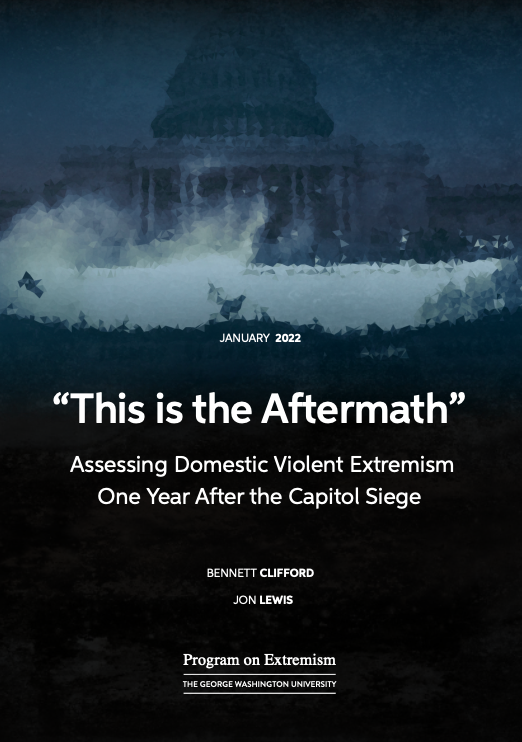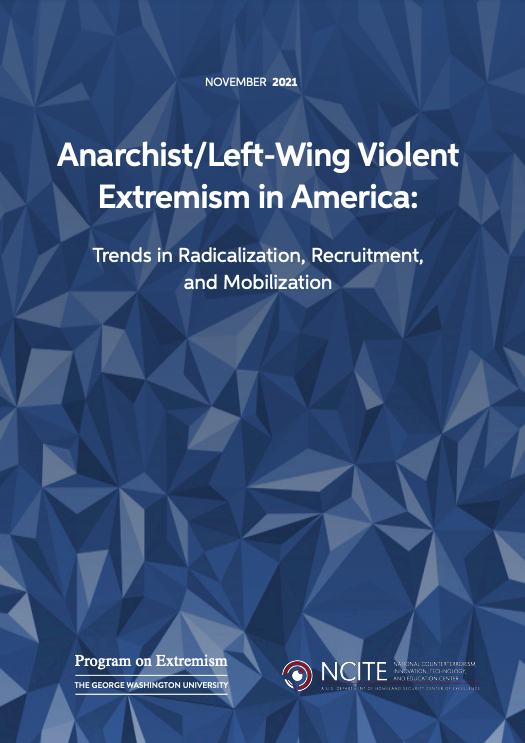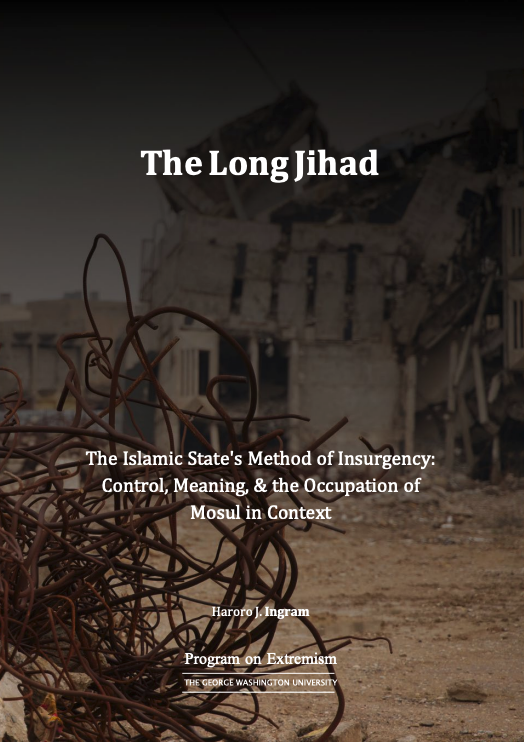Reports
This is the Aftermath: Assessing Domestic Violent Extremism One Year After the Capitol Siege
Authored by Bennett Clifford and Jon Lewis
January 2022
On the one-year anniversary of January 6, 2021, this report takes stock of the Capitol Siege’s impacts on domestic violent extremism in America, and the U.S. federal government’s efforts to respond to the threat over the past year. It analyzes the demographic and geographic backgrounds of the 704 individuals charged federally for their alleged roles in the Capitol Siege. The report finds that:
- Existing evidence shows limited correlation between an individual’s planning and coordination with domestic violent extremist groups prior to January 6th and their alleged participation in violent activities on January 6th. Examining the “spontaneous clusters”—individual siege participants who coordinated with others during the breach of the Capitol and jointly conducted violence—is vitally important to understand the nature of the violence at the Capitol and the potential for similar events in the future.
- Federal prosecutors allege that two domestic violent extremist networks were most responsible for mobilizing their followers to the Capitol on January 6th: the Oath Keepers and the Proud Boys. These groups have faced the bulk of the federal law enforcement pressure in the year following the Siege, with the varying degrees of decentralization in their leadership impacting 2021 mobilization.
- Since January 2021, the U.S. government has made massive changes to its domestic counterterrorism architecture at the strategic, operational, and tactical levels. In 2021, each major agency tasked with counterterrorism has adopted new policies and guidelines to address domestic violent extremism, in response to a first-of-its-kind push from the White House to develop a national strategy to counter domestic terrorism. This report assesses that countering domestic violent extremist groups after the Capitol Siege will require continued innovations in categorizing and analyzing groups and actors, as well as coordinating information sharing between federal, state, local, and non-governmental authorities.
Moderating Extremism: The State of Online Terrorist Content Removal Policy in the United States
Authored by Bennett Clifford
December 2021
By reviewing studies of how today’s terrorist and extremist groups operate on social media in conjunction with an overview of U.S. government regulation of terrorist content online, this report finds that stricter U.S. regulation of social media providers may not be the most effective method of combating online terrorist and extremist content.
Specifically:
• Direct governmental regulations that ignore other sources of regulation on content removal policies could disrupt growing intra-industry collaboration on countering terrorist content online.
• In many regards, the U.S. government defers to and depends on the private sector to conduct counterterrorism online. Many factors contribute to this arrangement, including limits on the government’s authorities, expertise, staffpower, dexterity and political will to manage online terrorist content with the same efficacy as major social media companies.
• Attempts by other governments to strictly regulate social media companies’ terrorist content removal policies hurt small companies, created double standards and redundancies, and raised concerns about censorship and free speech.
• Proposed regulations may only affect major U.S. social media providers; smaller and non-U.S. companies may be unable, unwilling, or not required to comply. Due to the proliferation of social media platforms exploited by terrorists and extremists, platforms that may be unaffected by U.S. government regulation currently host a large proportion of terrorist content online.
• In certain regards, major social media companies’ content removal policies have more flexibility than the U.S. government to be able to account for new terrorist and extremist groups and actors and their respective tactics, techniques, and procedures online.
Rise of the Reactionaries: Comparing The Ideologies of Salafi-Jihadism and White Supremacist Extremism
Authored by Alexander Meleagrou Hitchens, Blyth Crawford, Valentin Wutke
December 2021
Salafi-jihadism and right-wing white supremacist extremism are two of the most visible, active, and threatening violent extremist movements operating in the West today, responsible for dozens of attacks throughout North America and Western Europe. Despite key distinctions, both movements rely on ideas which, while vastly different in language and context, are rooted in a similar set of underlying structural processes and drivers. The purpose of this study is to identify and analyze these similarities, with the aim of contributing to the understanding of why both are enjoying a moment of increased popularity in the West today.
This report is structured around the five most important ideological overlaps identified by the authors: chauvinist collective identity, conspiracism, antisemitism, necessity and legitimacy of violence, and utopianism. Each of these has a dedicated chapter that both explains how these traits are manifested in each movement and provides a comparative analysis. How these traits are connected is also reflected in the order in which they are presented in the study, reflecting how one feeds into and is linked to the next.
By identifying both shared traits and divergence between these two movements, it is possible to gain a better understanding of the dynamics and appeal of two extremist movements that have found increasing bodies of support in the West. Such a comparison can therefore contribute to an understanding of how each movement addresses and appeals to the concerns, desires, and fears of their target populations.
Anarchist/Left-Wing Violent Extremism in America: Trends in Radicalization, Recruitment, and Mobilization
November 2021
Anarchist/left wing violent extremism, often referred to in United States government parlance with the catch-all term anarchist violent extremism, (AVE), has a long-standing history in the U.S. The political climate in recent years has intensified focus, interest, and controversy surrounding the activities of specific left-wing extremist currents. This paper attempts to situate AVE within the broader landscape of domestic violent extremist (DVE) threats facing the U.S. and chart the evolution of violent plots with a nexus to AVEs. In doing so, it analyzes a recent Federal Bureau of Investigation (FBI) and Department of Homeland Security (DHS) joint report that reviewed significant domestic terrorism incidents in the U.S. between 2015 and 2019.
This paper highlights three trends:
- Violence committed by AVEs in this period was largely locally organized, eventdriven, and/or opportunistic. However, individual AVEs inspired by the movement and its ideologies also planned mass-casualty terrorist attacks, predominantly against law enforcement, private property, and those they associate with opposing violent extremist groups.
- Individual AVEs also demonstrated interest in similar activities as other DVE groups—such as foreign fighter travel, disrupting government and/or electoral activities, and terrorism financing.
- Ongoing changes in the political, social, and economic climate in the U.S., as well as changes in the makeup, strength, and doctrines of other American domestic extremist groups, have the potential to escalate the frequency and lethality of violence committed by AVEs in the immediate future
The Muslim Brotherhood's Reaction to the Taliban's Return to Power
Authored by Sergio Altuna
November 2021
Islamists around the world have monitored the events in Afghanistan with great interest. The Taliban’s successful military offensive and subsequent return to power galvanized public displays of support from the movement’s regional allies, and especially from aligned Al-Qaeda supporters. While much attention has been paid to the reactions among various jihadist groups, there has not been much focus on the broader effects of the Taliban takeover on global Islamist movements, including the Muslim Brotherhood.
While a significant degree of uncertainty still surrounds the Taliban’s international agenda, prominent players within the Muslim Brotherhood have already signaled their unambiguous support for the group. This paper compiles those declarations of support by Muslim Brotherhood members, documenting various quotes, official statements, publications, media appearances, and more. The collection starts from the fall of Kabul and proceeds to the present, dividing quotes into two distinct categories according to their origin: 1) those made by members or groups of the global Muslim Brotherhood, and 2) those made by members or institutions specifically of the Muslim Brotherhood in the West. On the whole, the collection below provides evidence not only of the ideological affinities shared by the Taliban and the Muslim Brotherhood, but also reveals how the Brotherhood is adapting its discourse to incorporate and accommodate new narratives of the fall of Kabul to the Taliban.
The Long Jihad: The Islamic State's Method of Insurgency- Control, Meaning, & the Occupation of Mosul in Context
Authored by Haroro J. Ingram
September 2021
This study examines the Islamic State movement’s method of insurgency in both its theory (as articulated in the group’s internal and publicly disseminated documents) and its practice via an analysis of its capture and occupation of Mosul. Drawing on a variety of primary source materials including interviews, this paper presents a conceptual model of insurgency arguing that the Islamic State emerges as an exemplar case study of many key strategic mechanisms and psychosocial dynamics that are crucial for understanding modern insurgencies.
To these ends, this study has three key aims. First, it presents a conceptual framework for understanding modern insurgency as a dual contest of control and meaning. This model of insurgency, which builds on a range of sources including a global cross-section of insurgency doctrines, is then applied to the Islamic State. Second, this study analyses fourteen primary source documents that constitute the Islamic State’s insurgency canon. It then examines the Islamic State’s method of insurgency in practice with a particular focus on the years following its near decimation in 2007-08 through to its occupation of Mosul (circa 2014-17). Third, this study concludes by outlining a suite of research and policy recommendations based on its key conceptual and analytical findings. Overall, it hopes to contribute to not only literature examining the Islamic State but ongoing scholarly and practitioner debates on how best to understand modern insurgencies and its counterstrategy implications.
The Founding Fathers of American Jihad: The Impacts and Legacies of Anwar al-Awlaki, Samir Khan, and Ahmad Abousamra
Authored by Haroro J. Ingram and Jon Lewis
June 2021
This report assesses three individuals who played an outsized role in the evolution of English-language jihadist propaganda: The Americans Anwar al-Awlaki, Samir Khan, and Ahmad Abousamra. The study applies the CIP (Charismatic, Ideological, and Pragmatic) leadership framework to analyze and compare the legacies and impacts of the three. Drawing on the framework's life narrative approach, the report focuses on how 'life events' were leveraged in each of their eulogies to project these individuals as inspirational jihadi figures worthy of emulation.
Through this framework, al-Awlaki emerges as the quintessential charismatic leader, Khan as an ideological leader, and Abousamra as a pragmatic leader. These clear distinctions in leadership styles are reflective of the different personal attributes, backgrounds, and organizational contexts within which the individuals operated. Moreover, these differences in leadership characteristics shaped their respective impacts and legacies in ways that have important implications for the fields of research and practice.
Racially/Ethnically Motivated (RMVE) Attack Planning and United States Federal Response, 2014-2019
Authored by Bennett Clifford
May 2021
This report evaluates 40 cases of individuals charged in United States federal courts between 2014 and 2019, who are alleged to have planned or conducted violent attacks in the United States in furtherance of RMVE causes or ideologies. By evaluating the demographic, ideological, and
organizational backgrounds of the perpetrators, as well as their attack-planning methods
and processes, this report evaluates the successes and failures of federal law enforcement
in investigating and prosecuting RMVE attack planners.
The study recommends a data-driven reevaluation and reallocation of FBI and DOJ resources and staff dedicated to investigating and prosecuting RMVE. It also proposes broader information-sharing between federal, state, and local partners on RMVE threats, particularly between the FBI and local religious communities. Finally, the report argues that a federal statute that criminalizes acts of domestic terrorism, similar to 18 U.S. Code § 2332b, would be most applicable to prosecutions of attack planning cases involving RMVEs.
“This is War” Examining Military Experience Among the Capitol Hill Siege Participants
Authored by Daniel Milton and Andrew Mines
April 2021
This report explores military experience among those arrested in the January 6 Capitol incident. While the Capitol Hill siege is but one event in a longer history of military populations’ involvement in extremism, it offers a useful snapshot through which we can examine the scale and diversity of the issue. We present findings for a number of metrics accordingly, and provide some considerations for military officials, the general public, and policymakers.
At the time of writing, 43 of 357 individuals (12%) charged in federal court for their role in the Capitol Hill siege had some form of military experience. Of these 43 individuals, the vast majority (93%) were veterans and not currently serving in an Active Duty,
reservist, or Guard status. Individuals with military experience had, on average, 9 years of service experience. The range of experience was substantial, from 3
years on the low-end to 25 years on the high-end. Over one-quarter were commissioned officers, and 44% deployed at least once. Around one-third joined before 2000, and around 50% left the service over a decade ago.
The Islamic State in the Congo
Authored by Tara Candland, Adam Finck, Haroro Ingram, Laren Poole, Lorenzo Vidino, and
Caleb Weiss
March 2021
This report systematically examines how the efforts of the Islamic State to expand globally and the aspirations of Musa Baluku’s Allied Democratic Forces (ADF) merged in a mix of push and pull factors that resulted in the ADF becoming the Democratic Republic of the Congo (DRC) chapter of the Islamic State in Central Africa Province (ISCAP).
Based largely on primary sources, including a unique collection of defector and local source accounts, it tracks the ADF’s evolution from its Ugandan origins to being part of a formal province of the Islamic State, revealing unique insights into the group’s inner workings and its efforts to build transnational networks to support its operations.
The report finds that the ADF’s ties with the Islamic State may have started as early as 2017. By 2018, ISCAP was acknowledged as a formal province of the Islamic State, and in April 2019, ISCAP attacks in the DRC were first formally claimed by the Islamic State’s central media units.
To read the report in French, click here.
"This is Our House!" A Preliminary Assessment of the Capitol Hill Siege Participants
Authored by The Program on Extremism Staff
March 2021
This report offers new details about the individuals alleged to have stormed the nation's Capitol, as well as a number of recommendations for how to address the events of January 6th.
At the time of writing, 257 individuals have been charged in federal court for their involvement. They represent a heterogeneous group, with individuals as young as 18 and as old as 70 charged. They came to the Capitol from 40 states, and 91% traveled from outside the Washington, D.C. metropolitan area. 33 individuals have known military backgrounds. Some face as many as 17 counts on their indictment, and charges range from trespassing and illegal entry on designated grounds to seditious conspiracy against the U.S. government.
This report categorizes individuals according to three distinct categories: militant networks, organized clusters, and inspired believers. Based on the report's findings, we recommend that the U.S. government improve access to data on domestic terrorism investigations, conduct a systematic review of intelligence gathering and policy response to domestic terrorism alerts, and use existing structures to improve information-sharing between the federal agencies tasked with combating domestic violent extremism.
Antisemitism as an Underlying Precursor to Violent Extremism in American Far-Right and Islamist Contexts
Authored by Alexander Meleagrou-Hitchens Bennett Clifford, Lorenzo Vidino
October 2020
This report examines the foundational nature of antisemitism in multiple violent extremist movements in the United States, both violent and non-violent. American extremists incorporate antisemitic tropes and narratives in every level of their worldviews, using them to
help construct “us/them” dichotomies and wide-sweeping conspiracies that are essential to their movements.
During the past several decades, the American extremist movements that have been among the most violent—specifically, far-right and jihadist groups—have used antisemitism to target Jewish people, Jewish houses of worship, Jewish community institutions, and Americans supporting the Jewish state of Israel. The report provides case studies of violent American extremists, representing far-right and jihadist movements respectively, which demonstrate that antisemitism can be an integral part of American extremists’ progression through the radicalization process and in
justifying terrorist attacks.
Dollars for Daesh: Analyzing the Finances of American ISIS Supporters
Authored by Lorenzo Vidino, Jon Lewis, and Andrew Mines
September 2020
Dollars for Daesh analyzes both the tactics ISIS supporters in the U.S. used to raise and move funds, as well as the various types of networks from which individuals drew financial support. The authors drew on thousands of pages of court documents covering criminal proceedings dating from 2013 to the end of August 2020. The report was made possible through support from the National Counterterrorism, Innovation, Technology, and Education Center (NCITE).
Overall, the report shows that U.S.-based ISIS supporters left a small and unsophisticated financial footprint, with a few notable exceptions. Furthermore, individuals tended to operate as lone financial actors or in small clusters, which has mitigated the effectiveness of counter-terrorism financing policies and tools that have successfully targeted the larger and more sophisticated financing mechanisms of groups like Al-Qaeda, Hezbollah, and Hamas. The low-level and largely inconspicuous nature of these actors will likely pose a unique challenge to law enforcement efforts going forward. This report is part of a new Program on Extremism stream of research into terrorism financing, which aims to assess and explore these trends across a range of various extremist groups and ideologies.














